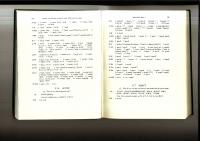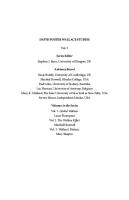Ditransitives in British English Dialects 9783110352320, 9783110352146
What determines whether we say She gave him a book instead of She gave a book to him? The author views this ‘dative alte
261 82 3MB
English Pages 251 [252] Year 2014
Acknowledgements
Contents
List of figures
List of tables
1 Introduction
1.1 Speaker choice, ditransitives, and the sociolinguistic variable
1.2 The scope of ditransitives
1.3 The corpora
1.3.1 Freiburg English Dialect Corpus (FRED)
1.3.2 BNCweb – The online edition of the British National Corpus (Lancaster platform)
1.3.3 Written data: LOB and F-LOB
1.4 Brief overview of the chapters
2 The ditransitive construction: previous studies
2.1 Introduction
2.2 Language-internal constraints on the dative alternation pertaining to the verb
2.2.1 Semantic considerations
2.2.2 Phonological and morphological constraints
2.3 Language-internal constraints on the dative alternation pertaining to the objects
2.3.1 Semantic considerations
2.3.2 Pragmatic constraints
2.4 Idiomatic expressions as a starting point: is there an alternation?
2.5 Overview of all the language-internal constraints on the dative alternation
2.6 Language-external constraints on the dative alternation – some studies
2.6.1 Gradient language-internal constraints as characterisations of varieties
2.6.2 Dialectological descriptions of ditransitive phenomena
2.6.3 Two dialect corpus studies
2.7 Conclusion
3 Methodology: Defining the object(s) of study
3.1 Introduction
3.2 Finding ditransitive verbs
3.3 Finding double objects
3.3.1 The object category Pro
3.3.2 The object category NP
3.3.3 Intervening material
3.4 Idiomatic expressions
3.5 The regional classification
3.6 Summary
4 Spoken style, written style – ditransitives in speech and in the written standard
4.1 Introduction
4.2 The spoken data: FRED and the BNCreg
4.2.1 Objects and object patterns in FRED and the BNCreg
4.2.2 Ditransitive verbs in FRED and the BNCreg
4.2.3 Diachronic analysis of the verb occurrence in FRED and the BNCreg
4.2.4 The verb give
4.3 The written data: LOB and F-LOB
4.3.1 Objects and object patterns in LOB and F-LOB
4.3.2 Ditransitive verbs in LOB and F-LOB
4.4 Comparison of the written and spoken data sets
4.4.1 Comparison of the object SETs
4.4.2 Comparison of the verb encodings
4.5 Conclusion
5 Object patterns in dialects of English: a regional and historical analysis
5.1 Introduction
5.2 Historical development of the object patterns
5.3 The most frequent pattern: SET A (She gave her a book) and its alternatives
5.4 Second in frequency: SET D (She gave the woman a book) and its alternatives
5.5 Marginal but instructive: SET C (She gave the woman it) and alternatives
5.6 Conclusion
6 "Give it me!" – Pronominal ditransitives in English dialects
6.1 Introduction
6.2 The regional dimension
6.3 The diachronic dimension
6.4 Other determining factors
6.4.1 Imperative versus declarative
6.4.2 Pronouns
6.4.3 Verb types
6.5 Summary
7 Conclusion and outlook: ditransitives in British and American English dialects and beyond
7.1 Recap: ditransitives in British English dialects
7.2 Ditransitives in American English dialects
7.3 Ditransitives in the languages of the world
Appendix
A: Levin's (1993) classes of verbs occurring only in PREP
B: Levin's (1993) classes of verbs occurring only in DOC
C: List of nouns taking sentential complements in FRED and the BNCreg
D: Light verb collocations with give in FRED and the BNCreg
List of data bases
Bibliography
Permissions
Index
Recommend Papers

- Author / Uploaded
- Johanna Gerwin
File loading please wait...
Citation preview
Johanna Gerwin Ditransitives in British English Dialects
Topics in English Linguistics
Editors Elizabeth Closs Traugott Bernd Kortmann
Volume 50.3
Johanna Gerwin
Ditransitives in British English Dialects
DE GRUYTER MOUTON
ISBN 978-3-11-035214-6 e-ISBN 978-3-11-035232-0 ISSN 1434-3452 Library of Congress Cataloging-in-Publication Data A CIP catalog record for this book has been applied for at the Library of Congress. Bibliografische Information der Deutschen Nationalbibliothek The Deutsche Nationalbibliothek lists this publication in the Deutsche Nationalbibliografie; detailed bibliographic data are available in the Internet at http://dnb.dnb.de. © 2014 Walter de Gruyter GmbH, Berlin/Boston Printing and binding: CPI buch bücher.de GmbH, Birkach ♾ Printed on acid-free paper Printed in Germany www.degruyter.com
Acknowledgements I am very grateful to Lieselotte Anderwald for granting me the opportunity to pursue this project in the first place, and for her inspiring, instructive and motivational supervision, her patience and faith in me and, perhaps most of all, for the many enjoyable lunches and coffee breaks we shared in larger and smaller company. I would also like to thank Bernd Kortmann of the University of Freiburg not just for laying the cornerstone of my present career but also that of this dissertation by making the FRED data available to me. I additionally thank Sebastian Hoffmann of the University of Trier for his kind and easy help with some of the BNCweb data. Many thanks are due to Uwe Vosberg, who generously helped out with issues of number and was never more than four digits away when needed, and to John A. Foulks for "proofing the diss" and "dissing the proofs" in the most excellent manner. Een heel groot Dankeschön an Jens Bahns för sin scharpen Ogen, and many thanks to Beke Hansen, Anna Rosen and Ingrid Schwede for lending me their great minds and their time. Finally, I would like to thank Julie Miess, Maria Dassing and Wolfgang Konwitschny of deGruyter Mouton for easing both the process and the feeling expressed by the German word "Druck" while preparing the manuscript. Kiel, March 2014
Contents Acknowledgements | v List of figures | x List of tables | xiii 1 1.1 1.2 1.3 1.3.1 1.3.2 1.3.3 1.4 2 2.1 2.2 2.2.1 2.2.2 2.3 2.3.1 2.3.2 2.4 2.5 2.6 2.6.1 2.6.2 2.6.3 2.7
Introduction | 1 Speaker choice, ditransitives, and the sociolinguistic variable | 1 The scope of ditransitives | 7 The corpora | 13 Freiburg English Dialect Corpus (FRED) | 13 BNCweb – The online edition of the British National Corpus (Lancaster platform) | 14 Written data: LOB and F-LOB | 16 Brief overview of the chapters | 17 The ditransitive construction: previous studies | 19 Introduction | 19 Language-internal constraints on the dative alternation pertaining to the verb | 20 Semantic considerations | 20 Phonological and morphological constraints | 37 Language-internal constraints on the dative alternation pertaining to the objects | 42 Semantic considerations | 42 Pragmatic constraints | 48 Idiomatic expressions as a starting point: is there an alternation? | 54 Overview of all the language-internal constraints on the dative alternation | 59 Language-external constraints on the dative alternation – some studies | 62 Gradient language-internal constraints as characterisations of varieties | 62 Dialectological descriptions of ditransitive phenomena | 64 Two dialect corpus studies | 67 Conclusion | 69
viii | Contents 3 3.1 3.2 3.3 3.3.1 3.3.2 3.3.3 3.4 3.5 3.6
Methodology: Defining the object(s) of study | 71 Introduction | 71 Finding ditransitive verbs | 72 Finding double objects | 76 The object category Pro | 81 The object category NP | 83 Intervening material | 86 Idiomatic expressions | 88 The regional classification | 89 Summary | 93
4
Spoken style, written style – ditransitives in speech and in the written standard | 94 Introduction | 94 The spoken data: FRED and the BNCreg | 95 Objects and object patterns in FRED and the BNCreg | 95 Ditransitive verbs in FRED and the BNCreg | 98 Diachronic analysis of the verb occurrence in FRED and the BNCreg | 103 The verb give | 107 The written data: LOB and F-LOB | 116 Objects and object patterns in LOB and F-LOB | 116 Ditransitive verbs in LOB and F-LOB | 118 Comparison of the written and spoken data sets | 123 Comparison of the object SETs | 123 Comparison of the verb encodings | 125 Conclusion | 130
4.1 4.2 4.2.1 4.2.2 4.2.3 4.2.4 4.3 4.3.1 4.3.2 4.4 4.4.1 4.4.2 4.5 5 5.1 5.2 5.3 5.4 5.5 5.6
Object patterns in dialects of English: a regional and historical analysis | 132 Introduction | 132 Historical development of the object patterns | 137 The most frequent pattern: SET A (She gave her a book) and its alternatives | 148 Second in frequency: SET D (She gave the woman a book) and its alternatives | 152 Marginal but instructive: SET C (She gave the woman it) and alternatives | 155 Conclusion | 163
Contents | ix
6 6.1 6.2 6.3 6.4 6.4.1 6.4.2 6.4.3 6.5
"Give it me!" – Pronominal ditransitives in English dialects | 166 Introduction | 166 The regional dimension | 171 The diachronic dimension | 180 Other determining factors | 191 Imperative versus declarative | 191 Pronouns | 193 Verb types | 196 Summary | 198
7
Conclusion and outlook: ditransitives in British and American English dialects and beyond | 200 Recap: ditransitives in British English dialects | 200 Ditransitives in American English dialects | 203 Ditransitives in the languages of the world | 211
7.1 7.2 7.3
Appendix | 216 A: Levin's (1993) classes of verbs occurring only in PREP | 216 B: Levin's (1993) classes of verbs occurring only in DOC | 217 C: List of nouns taking sentential complements in FRED and the BNCreg | 217 D: Light verb collocations with give in FRED and the BNCreg | 218 List of data bases | 221 Bibliography | 222 Permissions | 232 Index | 233
List of figures Figure 1: Figure 2: Figure 3: Figure 4: Figure 5: Figure 6: Figure 7: Figure 8: Figure 9: Figure 10: Figure 11: Figure 12: Figure 13: Figure 14: Figure 15: Figure 16: Figure 17: Figure 18: Figure 19: Figure 20: Figure 21: Figure 22: Figure 23: Figure 24:
The sociolinguistic variable | 3 Sociolinguistic variable with pronominal ditransitives | 5 Ditransitives as a sociolinguistic variable | 6 Deep structure of PREP according to Larson (1988) | 26 Dative shift from PREP to DOC according to Larson (1988: 353) | 27 Search interface of the BNCreg with the relevant restrictions chosen | 73 Logically possible object patterns and their SET letters | 79 Corresponding SETs (indicated by arrows) | 80 Region boundaries in the FRED and BNCreg data sets | 92 Object SET frequencies in the FRED and the BNCreg (all verbs) | 96 A-curve of verb occurrences in FRED and the BNCreg | 99 DOC and PREP encoding in FRED | 101 DOC and PREP encoding in the BNCreg | 101 DOC encoding in FRED and the BNCreg (striped bars indicate increase in DOC patterns) | 105 PREP encoding in FRED and the BNCreg (striped bars indicate increase in PREP patterns) | 105 Development of the individual DOC SETs for give across the two corpora (SETs





![Variable Grammars: Verbal Agreement in Northern Dialects of English (Linguistische Arbeiten) [1 ed.]
3484304960, 9783484304963](https://ebin.pub/img/200x200/variable-grammars-verbal-agreement-in-northern-dialects-of-english-linguistische-arbeiten-1nbsped-3484304960-9783484304963.jpg)



